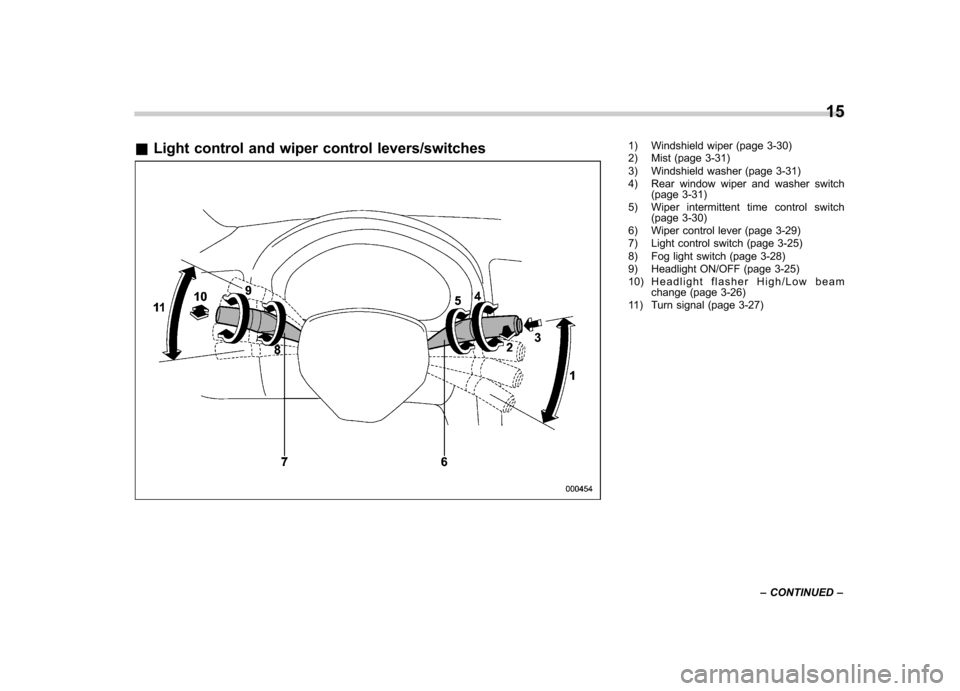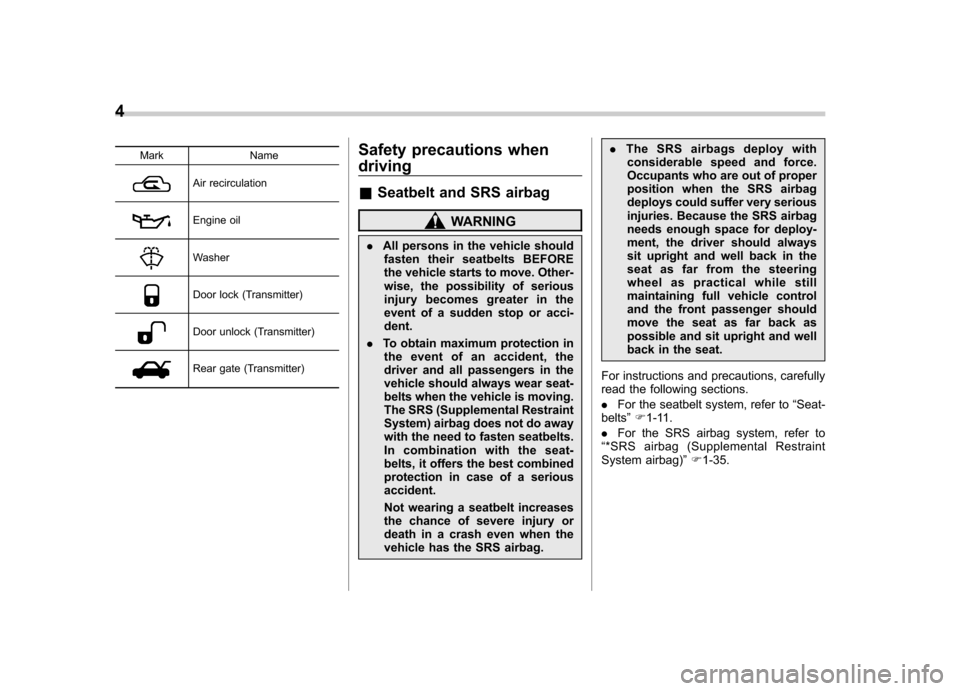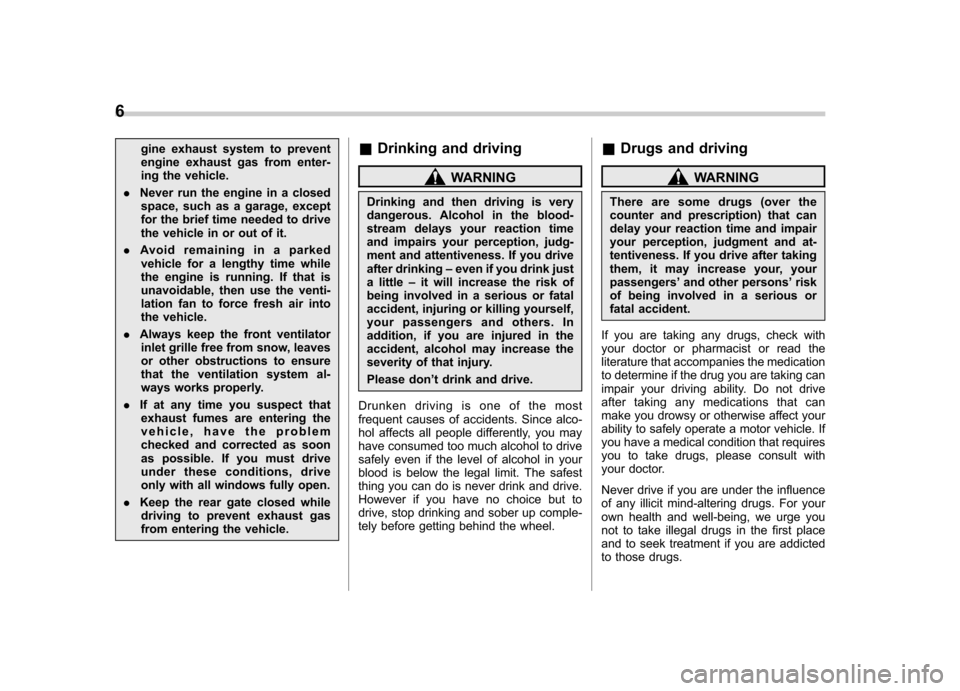SUBARU FORESTER 2010 SH / 3.G User Guide
Manufacturer: SUBARU, Model Year: 2010, Model line: FORESTER, Model: SUBARU FORESTER 2010 SH / 3.GPages: 402, PDF Size: 14.36 MB
Page 11 of 402

12 &Interior
! Passenger compartment area
1) Lower anchorages for child restraint
system (page 1-30)
2) Seatbelt (page 1-11)
3) Parking brake lever (page 7-31)
4) Front seat (page 1-2)
5) Rear seat (page 1-7)
Page 12 of 402

1) Center console (page 6-5)
2) Cup holder (page 6-8)
3) Front power supply socket (page 6-9)
4) Glove box (page 6-5)13
– CONTINUED –
Page 13 of 402

14 &Instrument panel
1) Door locks (page 2-4)
2) Outside mirror switch (page 3-39)
3) Illumination brightness control
(page 3-27)
4) Light control lever (page 3-25)
5) Combination meter (page 3-5)
6) Wiper control lever (page 3-29)
7) Hazard warning flasher switch (page 3-5)
8) Audio (page 5-1)
9) Shift lever (MT) (page 7-14)/ Select lever (AT) (page 7-15)
10) Climate control (page 4-1)
11) Cruise control (page 7-34)
12) Horn (page 3-43)
13) SRS airbag (page 1-35)
14) Tilt/telescopic steering (page 3-42)
15) Audio control buttons (page 5-28)
16) Fuse box (page 11-44)
17) Vehicle Dynamics Control OFF switch (page 7-29)
18) Hood lock release knob (page 11-5)
19) Power windows (page 2-20)
Page 14 of 402

&Light control and wiper control levers/switches1) Windshield wiper (page 3-30)
2) Mist (page 3-31)
3) Windshield washer (page 3-31)
4) Rear window wiper and washer switch
(page 3-31)
5) Wiper intermittent time control switch (page 3-30)
6) Wiper control lever (page 3-29)
7) Light control switch (page 3-25)
8) Fog light switch (page 3-28)
9) Headlight ON/OFF (page 3-25)
10) Headlight flasher High/Low beam change (page 3-26)
11) Turn signal (page 3-27) 15
– CONTINUED –
Page 15 of 402

16 &Combination meter
! U.S.-spec. models
1) Tachometer (page 3-8)
2) Speedometer (page 3-6)
3) Fuel gauge (page 3-8)
4) Trip meter A/B selection and trip meter
reset knob (page 3-6)
5) Odometer/Trip meter (page 3-6)
6) Select lever and gear position indicator (AT models) (page 3-21)
7) Coolant temperature low indicator light/ Coolant temperature high warning light
(page 3-13)
Page 16 of 402

!Except U.S.-spec. models1) Tachometer (page 3-8)
2) Speedometer (page 3-6)
3) Fuel gauge (page 3-8)
4) Trip meter A/B selection and trip meter
reset knob (page 3-6)
5) Odometer/Trip meter (page 3-6)
6) Select lever and gear position indicator (AT models) (page 3-21)
7) Coolant temperature low indicator light/ Coolant temperature high warning light
(page 3-13) 17
– CONTINUED –
Page 17 of 402

18
&Warning and indicator lights
Mark Name Page
Seatbelt warning light 3-10
Front passenger ’s seat-
belt warning light 3-10
SRS airbag system
warning light 3-11
/Front passenger
’s fron-
tal airbag ON indicator 3-12
/Front passenger
’s fron-
tal airbag OFF indicator 3-12
CHECK ENGINE
warning light/Malfunction
indicator lamp3-12
Coolant temperature low
indicator light/Coolant
temperature high warn-
ing light3-13
Charge warning light 3-14
Oil pressure warning light
3-14
AT OIL TEMP warning
light (AT models)
3-14Mark Name Page
/ABS warning light 3-16
/Brake system warning light
3-17
Door open warning light 3-18
AWD warning light
(AT models)
3-18
Hill start assist warning
light (MT models)
3-18
Vehicle Dynamics Con-
trol operation indicator light3-19
Vehicle Dynamics Con-
trol warning light/Vehicle
Dynamics Control OFF
indicator light3-19
Turn signal indicator lights
3-21
High beam indicator light 3-21
Automatic headlight
beam leveler warning
light (models with HID headlights)3-18Mark Name Page
Front fog light indicator
light (if equipped)
3-21
Security indicator light 3-20
Headlight indicator light 3-21
Cruise control indicator light3-21
Cruise control set indi-
cator light
3-21
Low fuel warning light 3-18
Low tire pressure warn-
ing light
(U.S.-spec. models)3-15
SPORT mode indicator
light (AT models)
3-20
Page 18 of 402

4
Mark Name
Air recirculation
Engine oil
Washer
Door lock (Transmitter)
Door unlock (Transmitter)
Rear gate (Transmitter)Safety precautions when driving &
Seatbelt and SRS airbag
WARNING
. All persons in the vehicle should
fasten their seatbelts BEFORE
the vehicle starts to move. Other-
wise, the possibility of serious
injury becomes greater in the
event of a sudden stop or acci-dent.
. To obtain maximum protection in
the event of an accident, the
driver and all passengers in the
vehicle should always wear seat-
belts when the vehicle is moving.
The SRS (Supplemental Restraint
System) airbag does not do away
with the need to fasten seatbelts.
In combination with the seat-
belts, it offers the best combined
protection in case of a seriousaccident.
Not wearing a seatbelt increases
the chance of severe injury or
death in a crash even when the
vehicle has the SRS airbag. .
The SRS airbags deploy with
considerable speed and force.
Occupants who are out of proper
position when the SRS airbag
deploys could suffer very serious
injuries. Because the SRS airbag
needs enough space for deploy-
ment, the driver should always
sit upright and well back in the
seat as far from the steering
wheel as practical while still
maintaining full vehicle control
and the front passenger should
move the seat as far back as
possible and sit upright and well
back in the seat.
For instructions and precautions, carefully
read the following sections. . For the seatbelt system, refer to “Seat-
belts ”F 1-11.
. For the SRS airbag system, refer to
“ *SRS airbag (Supplemental Restraint
System airbag) ”F 1-35.
Page 19 of 402

&Child safety
WARNING
. Never hold a child on your lap or
in your arms while the vehicle is
moving. The passenger cannot
protect the child from injury in a
collision, because the child will
be caught between the passen-
ger and objects inside the vehi-cle.
. While riding in the vehicle, in-
fants and small children should
always be placed in the REAR
seat in an infant or child restraint
system which is appropriate for
the child ’s age, height and
weight. If a child is too big for a
child restraint system, the child
should sit in the REAR seat and
be restrained using the seatbelts.
According to accident statistics,
children are safer when properly
restrained in the rear seating
positions than in the front seat-
ing positions. Never allow a child
to stand up or kneel on the seat.
. Put children aged 12 and under in
the REAR seat properly re-
strained at all times in a child
restraint device or in a seatbelt. The SRS airbag deploys with
considerable speed and force
and can injure or even kill chil-
dren, especially if they are 12
years of age and under and are
not restrained or improperly re-
strained. Because children are
lighter and weaker than adults,
their risk of being injured from
deployment is greater.
. NEVER INSTALL A REARWARD
FACING CHILD SEAT IN THE
FRONT SEAT. DOING SO RISKS
SERIOUS INJURY OR DEATH TO
THE CHILD BY PLACING THECHILD ’S HEAD TOO CLOSE TO
THE SRS AIRBAG.
. Always turn the child safety locks
to the “LOCK ”position when
children sit on the rear seat.
Serious injury could result if a
child accidentally opens the door
and falls out. Refer to “Child
safety locks ”F 2-19.
. Always lock the passenger ’s win-
dows using the lock switch when
children are riding in the vehicle.
Failure to follow this procedure
could result in injury to a child
operating the power window. Re-
fer to “Power windows ”F 2-20. .
Never leave unattended children
in the vehicle. They could acci-
dentally injure themselves or
others through inadvertent op-
eration of the vehicle. Also, on
hot or sunny days, temperature
in a closed vehicle could quickly
become high enough to cause
severe or possibly fatal injuries
to them.
For instructions and precautions, carefully
read the following sections. . For the seatbelt system, refer to “Seat-
belts ”F 1-11.
. For the child restraint system, refer to
“ Child restraint systems ”F 1-23.
. For the SRS airbag system, refer to
“ *SRS airbag (Supplemental Restraint
System airbag) ”F 1-35.
& Engine exhaust gas (carbon monoxide)
WARNING
. Never inhale engine exhaust gas.
Engine exhaust gas contains
carbon monoxide, a colorless
and odorless gas which is dan-
gerous, or even lethal, if inhaled.
. Always properly maintain the en- 5
– CONTINUED –
Page 20 of 402

6
gine exhaust system to prevent
engine exhaust gas from enter-
ing the vehicle.
. Never run the engine in a closed
space, such as a garage, except
for the brief time needed to drive
the vehicle in or out of it.
. Avoid remaining in a parked
vehicle for a lengthy time while
the engine is running. If that is
unavoidable, then use the venti-
lation fan to force fresh air into
the vehicle.
. Always keep the front ventilator
inlet grille free from snow, leaves
or other obstructions to ensure
that the ventilation system al-
ways works properly.
. If at any time you suspect that
exhaust fumes are entering the
vehicle, have the problem
checked and corrected as soon
as possible. If you must drive
under these conditions, drive
only with all windows fully open.
. Keep the rear gate closed while
driving to prevent exhaust gas
from entering the vehicle. &
Drinking and driving
WARNING
Drinking and then driving is very
dangerous. Alcohol in the blood-
stream delays your reaction time
and impairs your perception, judg-
ment and attentiveness. If you drive
after drinking –even if you drink just
a little –it will increase the risk of
being involved in a serious or fatal
accident, injuring or killing yourself,
your passengers and others. In
addition, if you are injured in the
accident, alcohol may increase the
severity of that injury.
Please don ’t drink and drive.
Drunken driving is one of the most
frequent causes of accidents. Since alco-
hol affects all people differently, you may
have consumed too much alcohol to drive
safely even if the level of alcohol in your
blood is below the legal limit. The safest
thing you can do is never drink and drive.
However if you have no choice but to
drive, stop drinking and sober up comple-
tely before getting behind the wheel. &
Drugs and drivingWARNING
There are some drugs (over the
counter and prescription) that can
delay your reaction time and impair
your perception, judgment and at-
tentiveness. If you drive after taking
them, it may increase your, yourpassengers ’and other persons ’risk
of being involved in a serious or
fatal accident.
If you are taking any drugs, check with
your doctor or pharmacist or read the
literature that accompanies the medication
to determine if the drug you are taking can
impair your driving ability. Do not drive
after taking any medications that can
make you drowsy or otherwise affect your
ability to safely operate a motor vehicle. If
you have a medical condition that requires
you to take drugs, please consult with
your doctor.
Never drive if you are under the influence
of any illicit mind-altering drugs. For your
own health and well-being, we urge you
not to take illegal drugs in the first place
and to seek treatment if you are addicted
to those drugs.